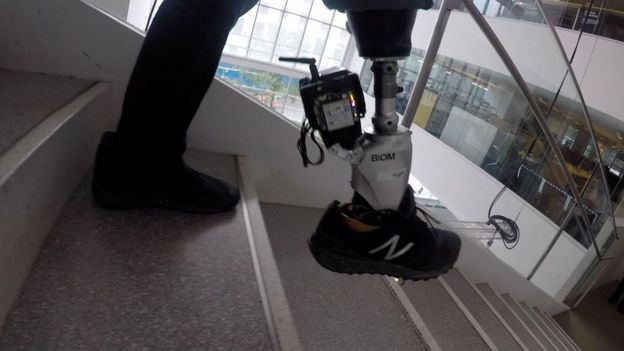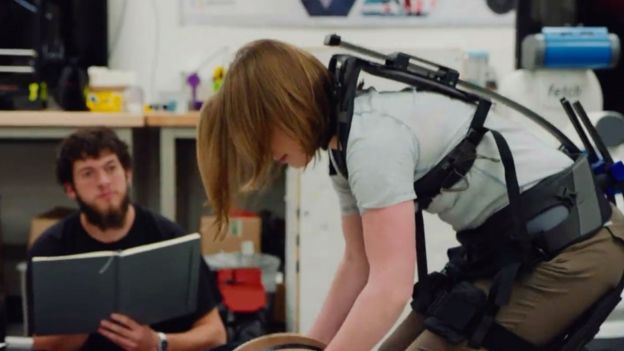"We’re at a key transition in human history,” says Prof Hugh Herr, who heads the Biomechatronics Group at the famed Massachusetts Institute of Technology (MIT).
He says the group’s aim is to establish the scientific and technological conditions that will eventually eliminate disability, whether through paralysis or amputation.
But that incredible goal has been achieved, then what?
"We’re fusing the nervous system with the built world,” he says.
"We’re transitioning from a relationship where we use technology that is separate from our nervous system, to a new epoch of integration, of human physiology."
Simulating ankles
Prof Herr is a double amputee. In 2012, I saw him move a room in London to tears when he revealed his incredibly sophisticated bionic legs that allowed him to move with natural poise and grace.
In 2014, Prof Herr’s technology meant Adrianne Haslet-Davis returned to the dancefloor, less than a year since losing a limb in the Boston marathon bombings. Her first performance after the incident brought a TED talk audience instantly to its feet.
I visited Prof Herr’s lab last week to learn more about the work is team is doing, and where it may lead. Right now, much of the research is focused on doing things the human body can do instinctively, but are extremely complex to engineer.

Roman Stolyarov, a researcher at the lab, demonstrated how they are using sensors similar to those found on self-driving cars to give prosthetic legs an awareness of what is around them.
This is important to make the leg behave differently when, for example, walking down stairs. The human brain, whether the person realises it or not, is able to instinctively prepare the leg for to land on a step. Teaching a prosthesis to do the same is the difference between having a bionic leg and, to put it crassly, a peg leg.
“The motor is able to work in such a way that simulates a real biological ankle joint,” Mr Stolyarov told me.
“The [leg] uses on-board sensors to infer whether the leg is in the air or on the ground, and perform actions that to the person feel much more like real walking than they would get from a passive prosthesis.”
The end result is that walking is considerably less tiring for amputees like Ryan Cannon, who lost his leg following complications after he broke it.
“I can move in a more rhythmic symmetrical way,” he told me.
"Being able to move in that manner allows me to walk at a faster pace for a longer distance and to do more activities during the day.”
Better, faster, stronger
But not all the work carried out here is about replacing limbs. It’s also looking at improving them.
One exoskeleton project reduces the physical exertion when walking by 25%, explained researcher Tyler Clites.
“What that means is, if you were to walk 100 miles, it would only feel to like you walked 75.
"We’re able to do that today. Those are devices I would expect to see rolling out commercially in the next several years.”
Beyond MIT, others are working on similar initiatives. US retail chain Lowes is piloting exoskeltons for staff, developed at Virginia Tech, that assist them with lifting at work.
“I definitely think that we are entering an age in which the line between biological systems and synthetic systems is going to be very much blurred,” Mr Clites said.

He said this future brings a concern that the rich and fortunate of the world may become physically superior, too.
“Then what you do is create a new baseline for physical ability, and perhaps mental ability, that’s only achievable by people who are already in a position of privilege.”
That said, Prof Herr said he is confident that as the cost of prosthetics gets lower, it won’t leave poorer people behind.
"The cost of robotics is going to plummet,” he said.
"It’s hard to predict whether there’ll be large separations in society."
Amputation reinvention
Before that day, work will be mostly focused on improving the lives of amputees. But in that endeavour, one of the obstacles hindering Prof Herr’s work is one of compatibility.
Much like an old computer peripheral that can't plug into a new laptop, nor can most amputees “plug in” to the latest technologies being developed in this lab.
To solve this, the team is urgently trying to change the way limbs are amputated.
"The method that is used today to amputate limbs has fundamentally not changed since the US civil war,” Prof Herr said.
"So while you’ve seen tremendous progress in mechatronics and robotics, you’ve not seen progress in how surgeries are performed to amputate limbs. That is now changing.
"We’re redesigning how limbs are amputated to create the right mechanical and electrical interfacing environment.”
He said this interfacing will join the brain directly to the limb, creating a sense among amputees that they are making their bodies whole again.
"What we’re experiencing clinically is that when we attach these limbs to people and we listen to their testimonials, they use language such as 'I have my limb back, I’m healed, it’s part of me’.”
Once that breakthrough is fully achieved - and there’s evidence of progress literally walking around Prof Herr’s lab - he said humans will surely begin to consider themselves eligible for an upgrade.
"We’ll be more open to using all kinds of materials to make up our bodies,” he said.






